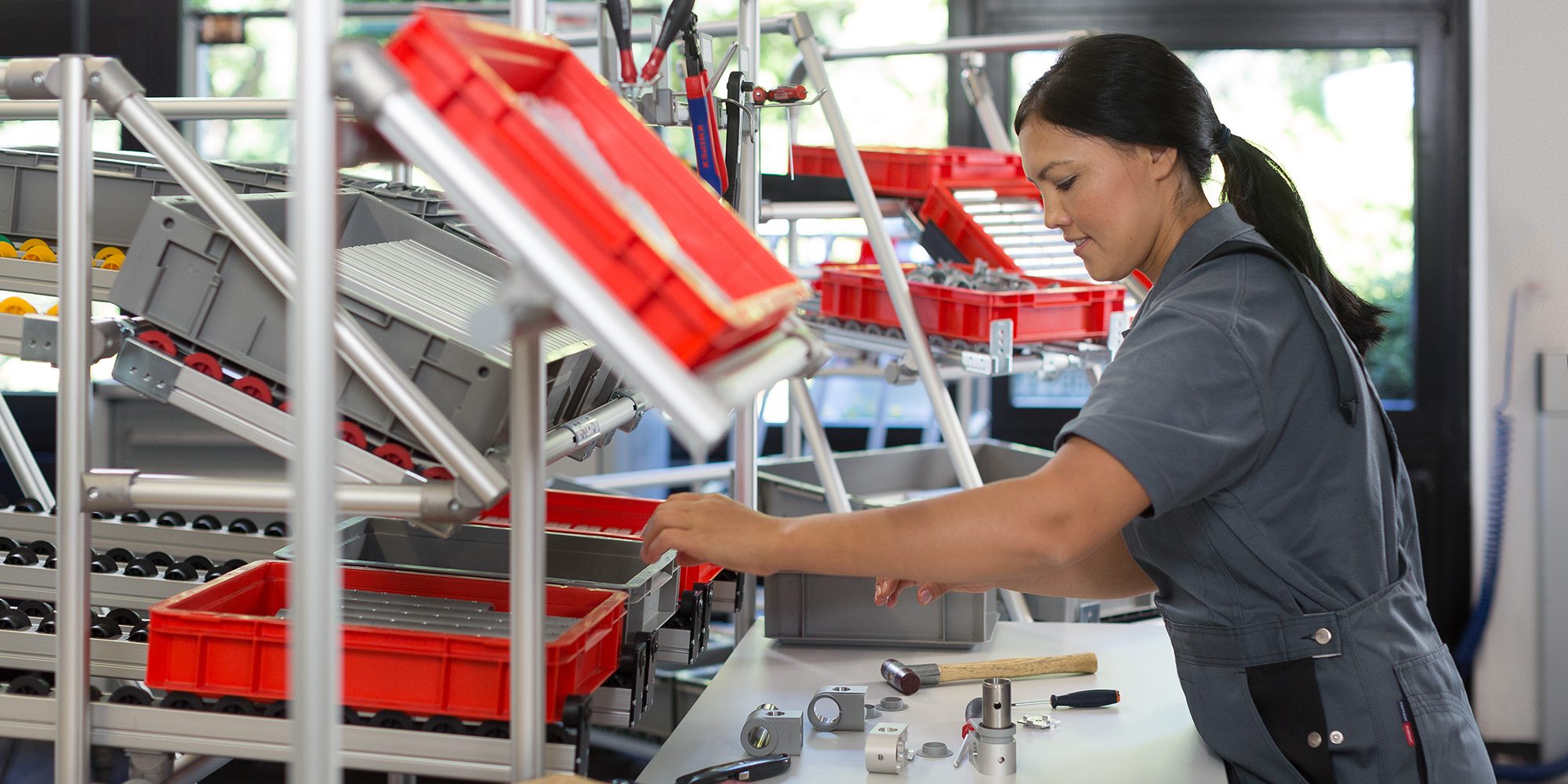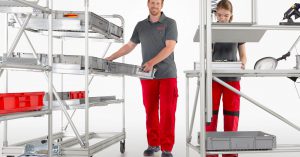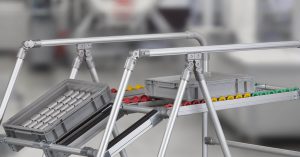In this blog post, we take a look back at the origins and development of lean production.
The lean production methods we use today can be traced back to the Toyota Production System (TPS). Contrary to what some might believe, lean production is not a term the car manufacturer Toyota actually uses. The expression was first popularised by a book written by James Womack, Daniel Jones and Daniel Roos (more on that later). In the early 20th century, a Japanese businessman named Sakichi Toyoda had already laid the foundations for the TPS, founding the Toyoda Spinning and Weaving Company in 1918. He developed an automated loom capable of detecting when one of the threads had torn and subsequently bringing the system to a halt. This basic idea later gave rise to Jidoka – a principle for detecting errors and one of the pillars underpinning the TPS. Creativity and innovative prowess would also go on to play a key role in shaping the development of this concept.

The world of lean production
Less waste and more added value – lean production methods let you make targeted improvements to your production efficiency. Our white paper provides a concise introduction.
GET YOUR COPY NOW
The invention of just-in-time production
The Toyota Motor Corporation, founded in 1937 by Sakichi’s son Kiichiro Toyoda and his cousin Eiji, took Jidoka to the next level, with Kiichiro ultimately developing the just-in-time principle. When implementing this approach, products are only manufactured when customer orders are actually received, as the name suggests. Here’s how the process works in practice – the material and production flow is arranged and controlled so that at any one time each manufacturing station in a continuous flow system has only the quantity of raw materials, parts and other materials it needs. This keeps stock levels low and removes safety buffers as much as possible.

Taiichi Ohno’s innovations
Taiichi Ohno, who started out as a production manager in Toyota’s main manufacturing plant in the 1950s, is considered the undisputed father of the Toyota Production System. Due to the consequences of the American occupation and scarce resources, the Japanese automotive industry was struggling to keep up with its U.S. competitors and lacked the necessary capital to build adequately sized plants and accumulate stock. At the same time, the Ford plants were viewed as a great model of efficient production, so both Kiichiro Toyoda and Taiichi Ohno travelled overseas to see these plants and their centrally controlled production line systems for themselves. Ford employees were not expected to show initiative – each worker was assigned a special task to carry out quickly and repeatedly.
Muda is a useless activity, contributing nothing to value creation.
Ohno identified two major disadvantages to this traditional, rigid form of mass production. Firstly, the conveyor belt was constantly in motion, meaning Ford was forced to store large volumes of preliminary products. Secondly, quality checks were only carried out on the finished vehicle. This resulted in high costs for warehousing and rectifying any faults. As a direct response to this, the Toyota Production System – and by extension lean production – focuses on avoiding waste, which is deemed a useless activity that contributes nothing to value creation. There’s a special word for this in Japanese – “Muda”. Here is a quick overview of the 7 Muda, or types of waste:
Superfluous movement of materials
Increased stock levels
Non-ergonomic movements
Avoidable waiting times
Overproduction
Over-engineering
Faults
The following memorable quote neatly summarizes Taiichi Ohno’s view on waste: “All we are doing is looking at the timeline, from the moment the customer gives us an order to the point when we collect the cash. And we are reducing the timeline by reducing the non-value-adding wastes.” However, the idea of non-value-adding activities is not limited to Muda. Mura (“imbalance”) and Muri (“overloading”) are certainly not to be underestimated, either. Together, these represent the three Ms (Muda, Mura and Muri), of which Mura is, in fact, the most significant factor.

Process optimization with item
From a FiFO shooter to a Karakuri application and new features in the Engineeringtool: Check out our videos and experience our highlights for lean intralogistics and more.
WATCH NOW
Major inspiration for the Toyota Production System
Another of Ohno’s talents was combining existing concepts and taking inspiration from outside the company to develop new, productive strategies. For example, not only did he combine just-in-time production with Jidoka, he also brought elements from U.S. companies into the mix. While he was rather disillusioned with the mass production lines he had visited, he was quite taken with American supermarkets and how well organised they were. After a purchase, i.e. once an item had been removed from the shelf, the shelf would be restocked, in keeping with the just-in-time concept and the pull principle. This made Ohno wonder whether such an approach could work in production, too. This gave rise to the Kanban principle, which also plays a key role in agile project management today.
Kaizen is made up of the Japanese words for “change” (Kai) and “for good” (Zen), so it’s all about seeing improvement as a never-ending process.
Ohno also recognised that the PDCA cycle, developed by American physicist and statistician William Edwards Deming, fit perfectly into the Japanese Kaizen concept. PDCA stands for Plan, Do, Check and Act and describes a precise and continuous strategy for improving processes. Kaizen is made up of the Japanese words for “change” (Kai) and “for good” (Zen), so this is another area where improvement is seen as a never-ending cycle because there is always an element in any process that can benefit from further optimisation. In the context of production, this is known as the continuous improvement process (CIP), which promotes a positive attitude towards mistakes, thus explicitly encouraging all employees to get involved. After all, they are the ones working at the place where value is created (also known as the Gemba).
The large-scale MIT study that changed it all
While the advantages of these Japanese principles went largely under the radar in the West for a long time, this all changed suddenly in the early 1990s. Between 1985 and 1990, the processes of automobile manufacturers around the world were analysed as part of a five million-dollar research project dubbed the International Motor Vehicle Program (IMVP). The results were published in a book by Womack, Jones and Roos titled “The Machine That Changed the World: The Story of Lean Production” (1990). This publication – often referred to as simply the “MIT study” – made headlines both within the automotive industry and beyond, selling over 600,000 copies. It also made waves in Germany, as reported by magazine DER SPIEGEL in April 1991: “The Japanese automotive industry has its competitors quaking in their boots – thanks to its state-of-the-art, flexible production methods. A team of American researchers have thoroughly examined the production methods used by Japanese manufacturers, drawing quite an alarming conclusion – the days of conventional mass production are numbered.”
The MIT study does not actually use the term ‘lean’ – in fact, this expression was first used by John Krafcik in his article ‘Triumph of the Lean Production System’.
It was, however, John Krafcik, another participant in the study, who coined the term “lean production” in his article “Triumph of the Lean Production System”, which was published in the autumn of 1988 and can be read in full here. Some of the examples Krafcik gives for “lean” approaches include minimising stock levels, which saves costs and makes it possible to quickly identify and solve quality problems, and setting up small areas for carrying out repairs. All these methods can be attributed to the fundamental belief that quality should be achieved within the actual process – and not outside of it.

Lean production – a global tour de force
Given the obvious advantages of these methods – now referred to as lean production – companies around the world began analysing, adapting and developing the principles popularised by the MIT study. One high-profile example is the German manufacturer Porsche, which adopted lean production in 1991. After visiting automobile factories in Japan and systematically changing its approach, the company managed to pull itself out of the red. This boost in productivity can be clearly illustrated by looking at two key performance indicators. While 4.9 sports cars were produced per employee in the 1989/90 financial year (before lean production was introduced), this figure had gone up to 8.5 by 1997/98. Between 1991 and 2014, the throughput time required to manufacture a Porsche 911 went down by 75 percent – an accomplishment that brings to mind Taiichi Ohno’s wise words on the reduction of throughput time.
Lean management, which has a major influence on the way companies are run today, can be traced back to the original principles of the Toyota Production System. Moreover, the boundaries between conventional and lean production have been blurred for some time now. Indeed, factory equipment based on special lean production building kit systems can deliver significant efficiency gains – particularly when it comes to intralogistics. That said, the widespread use of lean production has not only helped refine the associated methods, it has also ensured the continued development of the tools and equipment used to put them into action in the workplace. Experience with weak points, additional application areas and a whole range of individual improvement measures have ensured that the new generation of lean production building kit systems – such as the one offered by item based on Profile Tube System D30 – is much more efficient and robust than its predecessors.
Are you interested in fascinating reports and innovations from the world of lean production? Then we have just what you’re looking for! Simply subscribe to the item blog by completing the box at the top right!





